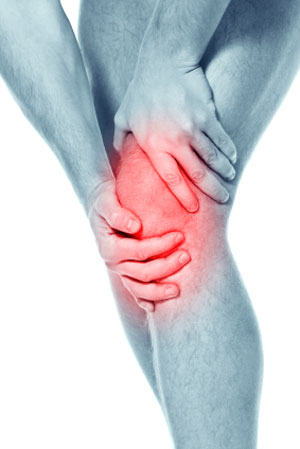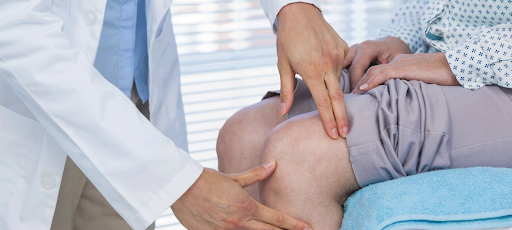People of all ages experience knee pain, and it has many causes. These causes include injuries like MCL tears, ACL tears, patellar fractures, or health issues like osteoarthritis or a sore knee. Knee injuries are common in younger people, but we all experience knee pain as we age. Often, knee pain responds well to self-treatment. But what doctor to see for knee pain? If you suffer from severe or chronic knee pain, it may be time to see a knee specialist.
The Dallas orthopedic surgeons at SPORT Orthopedics + Physical Therapy specialize in various treatments and surgeries, including torn rotator cuff surgery. Helping our patients heal and regain their physical abilities is our goal. Our staff knee specialists perform a thorough evaluation, determine the causes of knee pain, and help you eliminate knee pain.
What Is a Knee Specialist?
A knee specialist is also called an orthopedic doctor, orthopedic surgeon, or orthopedic knee specialist. They care for nerves, ligaments, joints, bones, and tendons that connect joints and bones.
As specialists, many focus on only a few parts of the musculoskeletal system.
Anatomy of the Knee
Knees are hinge joints. This means the knee moves forward and back with minimal movement to the side, not unlike a door. Four components make a knee: tendons, ligaments, bones, and cartilage.
Tendons
Tendons connect bone and muscle. They also attach other bodily components to muscles, such as the eyeball. Tendons are cord-like fibrous tissues that are flexible and help move the bones.
Ligaments
Ligaments connect bone to bone. They hold the bones together and the knee in place. The human knee contains four ligaments, each serving a distinct purpose.
Collateral Ligaments
The sides of the knee contain two collateral ligaments – one on the inside and one on the outside. They are responsible for the side-to-side knee movement.

Cruciate Ligaments
There are also two cruciate ligaments. These are inside the knee joint and cross to form an X. These ligaments control the backward and forward movement of the knee.
Bones
The femur, patella, and tibia bones meet to comprise the knee. These bones are also called the thigh bone, kneecap, and shinbone.
Cartilage
The knee contains two types of cartilage. These are meniscal cartilage and articular cartilage.
Meniscal Cartilage
There are two pieces of this type of cartilage in the knee. They are wedge-shaped and serve as cushions between the thigh bone and shinbone. The outer side of the knee features the lateral meniscus, while the inner side has the medial meniscus.
This cartilage stabilizes the joint, and acts as a shock absorber.
Articular Cartilage
This type of cartilage is slippery and serves as a lubricant inside the knee. It helps the bones slide across each other as the legs straighten or bend.


Causes and Risk Factors
Numerous factors contribute to or cause knee problems and pain.
Causes
Mechanical difficulties include a dislocated kneecap, knee instability, hip or foot pain that causes you to shift your weight to one side, Iliotibial Band Syndrome, ligament tears, and loose pieces of cartilage or bone in the joint. Iliotibial Band Syndrome happens when the band of tissue running from the outer hip to the outer knee becomes too tight. It can rub against the thigh bone if this happens. This is a common issue for cyclists and distance runners.
Of the more than 100 different types of arthritis, a handful can cause pain in the knee. Osteoarthritis and degenerative arthritis are the most common types.
Rheumatoid Arthritis is an autoimmune disorder. Including the knee, it can affect most joints in the body. This type of arthritis may make an appearance and then go away, severity varies, and it can be very debilitating.
If a knee joint becomes infected, septic arthritis can occur. The knee swells, becomes painful and red, and can be accompanied by fever. This type of arthritis can damage the knee cartilage in a short span. Arthritic symptoms and knee pain together may warrant a call to your knee specialists.
When uric crystals build up in the knee, gout develops. Although typically associated with the big toes, this type of arthritis also occurs in the knee. In pseudogout, calcium-containing crystals build up in the joint fluid.
Patellofemoral pain develops between the kneecap and the thigh bone. Athletes, young adults whose kneecap doesn’t move the correct way, and older adults with arthritis of the kneecap frequently suffer from this.
Risk Factors
The following factors increase the probability of experiencing knee pain:
- Being Overweight. The stress on the knee joints increases when the body carries excess weight.
- Muscle Strength or Flexibility Reduction. Knee injury risks go up when the surrounding muscles are weak or inflexible. When the muscles are strong, they help keep the knee stable and protect the joint.
- Sports-Related Injuries. Soccer, basketball, skiing, football, and tennis involve pivot movements that stress the knee.
- Prior Knee Injury. Your risk of knee injury is higher if you have a previous injury.
Knee Pain Symptoms
So, what sort of symptoms, besides pain, might you experience if you have knee issues? The pain level and location can vary. Symptoms typically accompanying knee pain include knee stiffness, tightness, swelling, red and warm skin, an unstable or weak knee, pain on the inside of the knee, and popping or crunching sounds.
When to See a Doctor for Knee Pain
It’s time to visit specialty-trained knee doctors for treatment if you are experiencing the following symptoms:
- Knee weakness
- Noticeable swelling in the knee area
- See a deformity or change in your leg or knee
- Limited range of movement
- Pain, swelling, and redness of the knee accompanied by fever
- Pain strikes after an injury
Issues Diagnosed?
Your orthopedic doctors will talk to you about your symptoms and conduct a physical examination. During the exam, your knee physician also checks your lower leg mobility and may pull or push on the knee to gauge the soundness of your knee structure. If your condition calls for more specialized treatment, your doctor may order tests and scans to make an accurate diagnosis.



What Are the Most Common Treatments for Knee Pain?
The severity and cause of your unique condition determine the best treatment for you.
Common knee care treatments include over-the-counter or prescription pain relievers and medications to treat any underlying health conditions like gout or rheumatoid arthritis. Stabilizing the joint with physical therapy, braces for the knee joint, arch supports or supportive footwear, and injections into the joint. Examples of injectables include corticosteroids, hyaluronic acid, and platelet-rich plasma.
When Is It Time to Consider Knee Surgery?
Your physician may suggest surgery if less invasive therapies don’t provide relief.
Arthroscopic Surgery
Among your surgical options is arthroscopic knee surgery. The orthopedic surgeon makes tiny incisions for this procedure and uses a fiber-optic camera to view the joint damage. They insert long, thin tools to make repairs. Damaged cartilage can be removed or repaired, ligaments reconstructed, and loose bodies removed from the joint.
Partial Knee Replacement
Parts constructed of plastic and metal replace the most damaged knee parts. This surgery also consists of tiny incisions, which reduce recovery time.
Total Knee Replacement
The recovery time for a total knee replacement is much longer than for a partial joint replacement. Artificial joints replace damaged cartilage and bones. Polymers, metal alloys, and high-grade plastics make up the new joint.
Osteotomy
Your orthopedic surgeon may recommend this procedure to help put off or avoid a total replacement. Arthritis relief and improved knee alignment are the end goal of removing bone from the shinbone or thighbone.
Knee Injuries and Conditions That We Treat
At SPORT Orthopedics + Physical Therapy, our Dallas orthopedic surgeons and physical therapists provide a variety of therapies, treatments, and surgical options for knee pain.
Conditions we treat include:
- ACL Sprains
- ACL Tears
- Cartilage Injuries
- Patellar Fracture
- Hyperextended Knee
- Knee Clicking
- Knock Knees in Children
- MCL Sprain
- Meniscus Tears
- Osteoarthritis
- Runners Knee (Patellar Chondromalacia)
- Sore Knee
- Sprained Knee
Among the surgeries our orthopedic surgical team offers that target knee or knee-related conditions are:
- ACL Reconstruction
- Bilateral Knee Replacement
- Cartilage Transplant
- Knee Arthroscopy
- Knee Replacement
- Joint Replacement
- Meniscus Repair
Best Knee Doctor Near Me in Dallas and Frisco, Texas
Where can I find an orthopedic doctor near me? Our team of knowledgeable and experienced orthopedic surgeons and physical therapists at SPORT Orthopedics + Physical Therapy work diligently to help our patients get back to good health. We are here for you if you suffer from knee pain or any other ailments limiting your active life.
In addition to knee problems, we treat a range of conditions, including carpal tunnel, rotator cuff tears, and pediatric injuries. Request an appointment today with a knee doctor near me. Please call (469) 200-2832, or fill out our online intake form to schedule an appointment.






